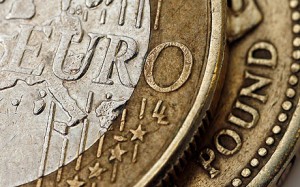 Yesterday’s trade saw EUR/GBP within the range of 0.7897-0.7949. The pair closed at 0.7916, losing 0.30% on a daily basis.
Yesterday’s trade saw EUR/GBP within the range of 0.7897-0.7949. The pair closed at 0.7916, losing 0.30% on a daily basis.
At 7:24 GMT today EUR/GBP was unchanged for the day to trade at 0.7916. The pair touched a daily low at 0.7915.
Fundamentals
Euro zone
Spanish Gross Domestic Product – final estimate
The final estimate of Spains annualized Gross Domestic Product probably confirmed the preliminary estimate, reported on October 30th, which pointed to 1.6% growth during the third quarter of the year. In Q2 economy expanded at an annualized pace of 1.2%, according to final data, released on August 28th.
On a quarterly basis, the final GDP estimate probably also confirmed the preliminary value, which showed an expansion of 0.5% in Q3, following a 0.6% growth during the second quarter. Preliminary data showed Spanish economy grew for a fifth consecutive quarter in Q3 in line with market expectations. The preliminary figure also came in consonance with Bank of Spains estimate. The central bank said in October that domestic demand rose 0.6%.
Third quarter GDP estimates were calculated in accordance with the new European System of Accounts 2010 (ESA 2010), introduced by the Eurostat. The new measure takes into account activities such as research and development spending and expenditure on weapon systems, which were not included before.
In case a faster-than-projected rate of growth was reported, this would have a positive effect on the single currency. The National Statistics Institute (INE) is to publish the final GDP estimate at 8:00 GMT.
Spanish Consumer Price Index (CPI) – preliminary estimate
Spain’s annualized consumer inflation probably decelerated to -0.3% in November, the preliminary estimate is expected to reveal today. If so, this would be the fifth consecutive month of negative inflation. In October the annual rate of inflation was reported at -0.1%, according to final data, released on November 13th. In October the largest downward pressure came from sectors such as communications (a 5.7% annual drop), leisure and culture (- 1.9%) and transport (-1.1%). The largest upward pressure was reported for housing, water, electricity (an annual increase of 1.3% in October, following a 2.2% gain in September) and education (+1.2%). In October consumers also paid more for hotels and restaurants (a 0.6% increase), alcoholic drinks and tobacco (+0.6%) and clothing and footwear (+0.3%).
Key categories, included in Spans Consumer Price Index (CPI), are food and non-alcoholic beverages (accounting for 20% of the total weight) and transport (15%). Other categories are real estate (12%), hotels, coffee and restaurants (11.5%), clothing and footwear (9%) and entertainment and culture (7.5%). Health, communication, education and other goods and services comprise the remaining 25% of the index.
The CPI measures the change in price levels of the abovementioned basket of goods and services from consumer’s perspective and also provides clues over purchasing trends. In case the CPI dropped more than projected, this would have a bearish effect on the euro. The National Statistics Institute (INE) will release the preliminary inflation data at 8:00 GMT.
Spanish preliminary annualized CPI, evaluated in accordance with Eurostat’s harmonized methodology, probably dropped 0.3% in November, following a 0.2% dip in October, as reported on November 13th.
German unemployment
The number of the unemployed people in Germany probably dropped by 2 000 in November, according to the median forecast by experts, following a decrease by 22 000 during October. The latter has been the most significant monthly decline since April, when unemployed were 25 000 less. A decrease implies that consumer spending may be more active, while the latter is tightly related to economic growth. An increase suggests the opposite.
At the same time, the seasonally adjusted rate of unemployment in the country probably remained unchanged at 6.7% in November, according to expectations. If confirmed, this would be the tenth consecutive month, during which the rate remains at this level. In September roughly 2.09 million people were unemployed in Germany, or an increase by 387 000 persons in comparison with September 2013. Adjusted for seasonal and irregular effects, the number of unemployed was 2.14 million in September, according to Destatis. The number of people in employment rose by 191 000, or 0.4%, in September compared to August, which was due to the beginning autumn upturn.
In case the number of people unemployed decreased more than projected and the unemployment rate dropped, this would certainly support demand for the euro. The Federal Statistics Office will release the official data at 8:55 GMT.
Italian Business confidence
Confidence among manufacturing companies in Italy probably remained almost unchanged in November, with the corresponding index coming in at 95.9, from 96.0 in October, as the latter has been the highest index reading since July, when the indicator stood at 99.1.
The Manufacturing Confidence survey features 4 000 Italian companies. Respondents give their opinion regarding the current trend of order books, production and inventories, short-term forecasts on order books, production, prices and the general economic situation.
The index of business confidence is seasonally adjusted and has a base year of 2005. Readings of 100.0 signify neutrality in business sentiment. Values exceeding 100.0 imply improving confidence, while values below 100.0 are related with low expectations. Lower-than-anticipated values may have a limited bearish effect on the common currency. The official reading by Istat is due out at 9:00 GMT.
Euro zone Economic Sentiment
Confidence among consumers in the Euro area probably worsened in November. The final value of the consumer confidence index probably confirmed the preliminary reading of -11.6, which was reported on November 20th. If so, this would be the lowest level of confidence since February, when the indicator stood at -12.7. The final index for October came in at -11.1, confirming the preliminary estimate. The indicator measures consumer confidence on a scale of -100 to +100. A reading of -100 suggests a lack of confidence, zero means neutrality and a reading of +100 indicates extreme levels of confidence. The index reflects the level of optimism, which consumers have about economic development in the region. The Business and Consumer Survey is conducted by phone and includes 23 000 households in the Euro zone. The questions asked stress on current economic and financial situation, savings intention and also on expected developments regarding consumer price indexes, general economic situation and major purchases of durable goods. This indicator is one of the five major components, that comprise the Economic Sentiment Indicator (ESI).
The ESI probably slipped to 100.3 in November, according to expectations, from a reading of 100.7 in October. The latter has been the highest level since July, when the index was reported at 102.1. The Economic Sentiment Indicator (ESI) is a composite indicator, consisting of five sectoral confidence indicators with different weights: Industrial confidence indicator, Services confidence indicator, Consumer confidence indicator, Construction confidence indicator and Retail trade confidence indicator. The ESI is calculated as an index with mean value of 100.0 and standard deviation of 10 over a fixed standardised sample period.
Lower confidence usually implies lesser willingness to spend, including large-ticket purchases, while consumer spending is a key factor behind economic growth. Therefore, in case the ESI dropped more than anticipated, this would cause a bearish impact on the euro. The European Commission is expected to release the official ESI reading at 10:00 GMT.
German Consumer Price Index (CPI) – preliminary estimate
German preliminary annualized consumer inflation probably decelerated to 0.7% during the current month, according to the median forecast by analysts, from 0.8% in October. If so, this would be the lowest annual inflation since February 2010, when the final CPI rose 0.6%. Energy prices dropped at an annualized rate of 2.3% in October. Prices were down in particular for light fuel (-10.8%) and motor fuels (-3.5%). Prices of electricity, on the other hand, were up 1.8%. Food prices rose 0.7% year-on-year in October, while cost of services rose above average, or 1.7% in comparison with October 2013, supported mostly by an increase of 1.6% in net rents, according to the report by Destatis.
The Consumer Price Index (CPI) presents a general picture of the price change in the country, while encompassing all household types, all regions and all goods and services demanded (food, clothing, automobiles, rental, repair and hairdressing services etc). The index is based on a basket of goods and services, which is regularly renewed, so that goods and services, purchased more often by consumers, are included in the present survey.
Nations preliminary annualized CPI, evaluated in accordance with the harmonized methodology, probably also decelerated to 0.6% in November, after being at 0.7% in October and at 0.8% in September, August and July. If so, this would be the lowest annual inflation rate since May, when the HICP rose 0.6%. The harmonized methodology is used for the sake of consumer inflation comparison in an international context (member-countries in the Euro area). In case the CPI came below expectations and further distanced from the 2-percent inflation objective, set by the European Central Bank, this would certainly mount selling pressure on the euro. Destatis is scheduled to publish the CPI report at 13:00 GMT.
Pivot Points
According to Binary Tribune’s daily analysis, the central pivot point for the pair is at 0.7921. In case EUR/GBP manages to breach the first resistance level at 0.7944, it will probably continue up to test 0.7973. In case the second key resistance is broken, the pair will probably attempt to advance to 0.7996.
If EUR/GBP manages to breach the first key support at 0.7892, it will probably continue to slide and test 0.7869. With this second key support broken, the movement to the downside will probably continue to 0.7840.
The mid-Pivot levels for today are as follows: M1 – 0.7855, M2 – 0.7881, M3 – 0.7907, M4 – 0.7933, M5 – 0.7959, M6 – 0.7985.
In weekly terms, the central pivot point is at 0.7953. The three key resistance levels are as follows: R1 – 0.8003, R2 – 0.8092, R3 – 0.8142. The three key support levels are: S1 – 0.7864, S2 – 0.7814, S3 – 0.7725.





